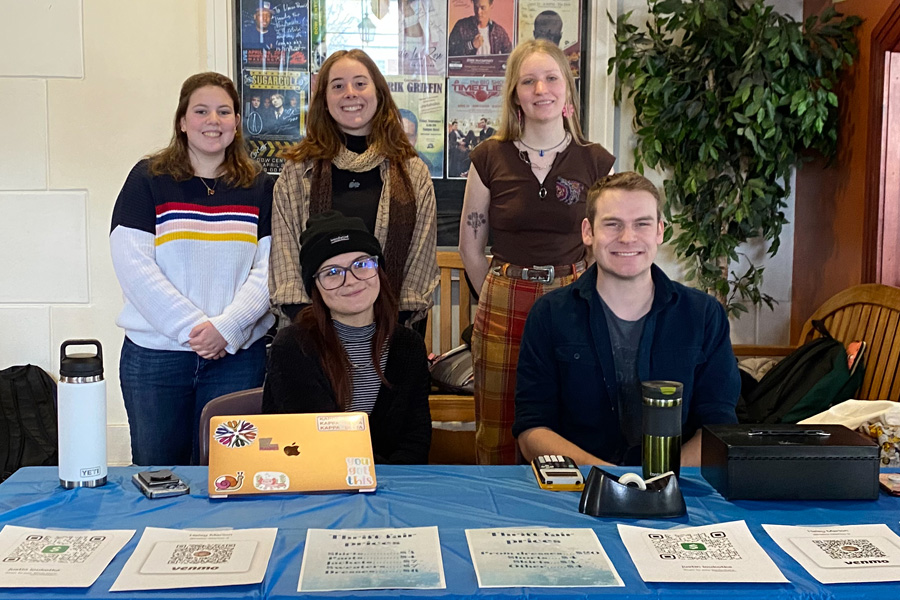Students turn trash to cash with sustainability thrift sale
With an eye to slowing down ‘fast fashion’ on campus, the five students also added $1,300 to the Center for Sustainability and the Environment’s green fund.
May 16, 2023

Haley Marion, ’23, Justin Loukitka, ’23, Alaina Shepardson, ’25, Delia Nieves, ’24, and Uma Shuford Williams, ’24, organizers of the CSE’s first thrift sale.
By Jake Weber
On most college campuses, the end of the semester means saying goodbye to students – then dealing with dumpsters bursting with discarded items. Yes, there is a lot of trash, but also many items that look like they were used once and then discarded, including clothes.
Those castoff clothes were on the minds of five students (Alaina Shepardson, ’25, Delia Nieves, ’24, Haley Marion, ’23, Justin Loukitka, ’23, and Uma Shuford-Williams, ’24) in Earth and Environment professor Thom Wilch’s Sustainability Projects course. They developed an idea to help reduce that waste and, in the process, netted $1,300 that will support future sustainability projects.
“I was hoping we might make $500,” said Shepardson, an environmental science major. “It was emotional, to see how well our project turned out and how many people had an interest in what was originally a homework assignment.”
The group’s project focused on the unsustainable nature of “fast fashion” – inexpensive clothing intended to be worn for a few months before being discarded. The concept relies on poorly paid laborers in developing countries and contributes to landfill (and college dumpster) overuse.
Even on Albion’s campus, castoffs are an issue. “At the end of the year, the dumpsters are full of things students don’t want to take home or don’t have room to take home,” Shepardson said. “We thought a thrift sale on campus would give these clothes a second life and slow down the cycle.”
The team spent at least 150 hours this semester gathering donated clothing, working with College departments to organize storage and sales spaces and recruiting volunteers to help set up, staff and tear down the sales. They originally planned just one sale, but the January event went so well, they had a second sale in March.
“From planning the specifics to executing the event, everyone involved was excited to be part of the sale,” said Marion, an environmental science major with a Ford Institute concentration. “We could not have done this without the help of other members of CSE, Greek life members, facilities staff members and other staff and students who worked to make this happen.”
“It’s nice to have an event with cute clothes that are really cheap, especially because everybody can’t get off campus,” said shopper Daniah Beavers, ’24. “I love hoodie sweatshirts, and I’m very glad I bought some.”
Beavers and her friend Elle Randrianaina, ’24, were happy to learn the sale was helping reduce waste on campus.
“There’s some really nice things here. We shouldn’t spend a lot of money on new things when we have the chance to reuse stuff,” Randrianaina said.
The end result was an event that exceeded everyone’s expectations while providing a windfall for the CSE’s “green fund.” All proceeds going into this fund will, in turn, support other student-led sustainability projects.
Wilch, who also serves as CSE’s faculty director, noted other students are developing intriguing class projects, including a collaboration with Metz dining on healthy and sustainable eating, a pollinator garden planting and a bikeshare proposal.
“All of the projects reflect and magnify CSE’s mission to empower students to be environmental and social change-makers,” Wilch said. “These particular students are all thrifters themselves, and their passion for thrifting and dedication to the project goals were keys to their success.”
Nieves, an environmental studies major, noted: “I’m really hoping that we can do the thrift fair again next year because it was super successful this year. If this becomes an annual event, I think it could be a nice source of community for the campus and a good way of bringing in money for future projects created by students.”